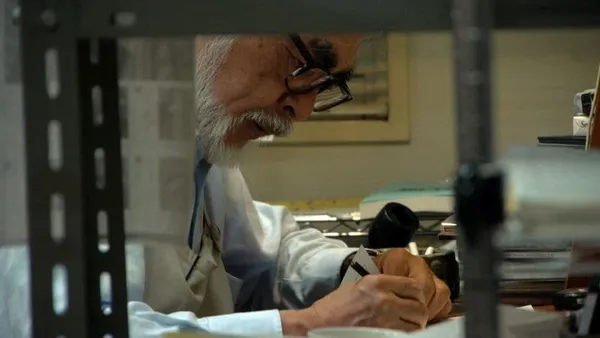Eye For Film >> Movies >> The Kingdom Of Dreams And Madness (2013) Film Review
The Kingdom Of Dreams And Madness
Reviewed by: Anne-Katrin Titze

In Mami Sunada's perceptively indelible The Kingdom Of Dreams And Madness (Yume To Kyôki No Ohkoku), calm and steady and without any fuss the petals unfold, revealing a core of care for this world we live in from animator king Hayao Miyazaki and his friendly rival and colleague Isao Takahata.
She shows us an up-close inspection of a captivatingly normal workplace and opens the doors to the famous Japanese Studio Ghibli, which includes a museum and in-house nursery. Sunada's approach is subtle. It is taken for granted that the audience is familiar with the studio's work. Miyazaki, who brought us masterpieces like My Neighbour Totoro (Tonari No Totoro), Spirited Away (Sen To Chihiro No Kamikakushi), or Howl's Moving Castle (Hauru No Ugoku Shiro) is seen storyboarding his latest pearl, the incomparable The Wind Rises (Kaze Tachinu).

The men and women (and cat and stuffed toy goats) and the building itself are what interest her. The filmmaker, who first set foot there in autumn 2012, has her camera linger on a sheer endless supply of intriguing details: the staircase, the meadow outside, the yellow flowers and the industrial landscape in the distance, a Totoro cuckoo clock and a basket with a little sign saying "lots of used pencils here, please use them."
The mood is that of an office in which at any moment, anything is possible, a little bit like in the films created here. What can you expect of a company named after the dust-carrying North African fierce wind of the desert that is said to influence your state of mind, similarly to the warm Foehn breeze of the Alps?
Hayao Miyazaki loves routine, we find out, as the camera follows him walking through the corridors, dressed in a white apron with very small creatures embroidered on a single low pocket. He arrives at 11AM and stops working at precisely 9PM and never takes a vacation or a Saturday off. On Sundays, he goes to clean the river. Of the 400 employees, over 100 are working on The Wind Rises in various capacities. Calisthenics breaks are frequent and in the evening for sunset, Miyazaki and his team go to the roof of the building and look at the sky as a daily ritual. The clouds in a Ghibli film will never look the same.
A script for a Miyazaki film does not exist and instead is replaced by the master's storyboards. Usually, "production begins over a year before the storyboards finish," we learn, so nobody knows how the film will end. While he draws his images for a sequence of The Wind Rises, with parts of the Paul Valéry poem glued on the page, he explains how "the film writes itself." In the case of Spirited Away no one understood what he was doing, even he himself. It does not sound as if he's joking.
Toshio Suzuki, producer for both Miyazaki and Isao Takahata, has known the filmmakers for 35 years. "He would be a fine detective," is the word about Suzuki, who met Miyazaki at the beginning of his career when Suzuki was told to launch an animation magazine in three weeks without having a clue about animation.
Hanging out on top of a wooden picnic table, we encounter Ushiko, a relaxed white cat with a Cindy Crawford beauty mark who is a longtime Ghibli resident. In a movement that puts Disney's Lucifer from Cinderella to shame, Ushiko gets up, turns around and unmistakably tells the camera where it can go.
Follow that cat, Sunada, who is her own DP, could have used as her motto in regards to camera movement. We get glimpses into meetings, learn how the leading market for Ghibli merchandise is for adults, not children and attend a press conference during which it is announced that Ghibli will simultaneously release The Wind Rises and Takahata's The Tale Of The Princess Kaguya (Kaguyahime No Monogatari). This, of course we know now, did not happen. The episode cleverly introduces us to Isao Takahata who, they lovingly tell the press, never finished a movie on time or within budget.
The man who is "trying not to finish films," is best known for the anti-war film Grave Of The Fireflies (Hotaru No Haka) and the ecological thriller Pom Poko (Heisei Tanuki Gassen Ponpoko). The elusive Takahata pushed the subjects of animation into territories others were afraid of and was initially Miyazaki's mentor. The strategy to pit the two filmmakers with their very different working methods against each other in a race to the film finishing line, is only mildly effective, their producer knows. They were partners on the TV series Heidi, which was subject of a recent exhibition at the Ghibli museum and the reason why Miyazaki has two life-size stuffed goats on the window sill at his house. "I couldn't bear to see them sitting in storage."
Miyazaki calls himself a man of the 20th century who can't deal with the 21st. He started taking pictures of ordinary days and put them in a scrapbook he titled "The Depression" after 2008. On March 11, 2011 the great Pacific Earthquake causing the Fukushima Nuclear Power Plant disaster is a marker for him of our "cursed dreams."
It is lovely to witness the casting of the voice of Jiro (Hideaki Anno), protagonist of The Wind Rises and very dear to the creator's heart, or learn why "will" always has to trump "fate" in animation. The film becomes far more than that when Miyazaki talks about what he sees happening in the world at present.
A "sense of dread in the air" and the feeling "almost that younger people have given up already" explains to him something about the generation of his own parents. When the man who gave us the most wonderfully strong little girls who go out into the world with open eyes and reassuring little animal sidekicks, is expressing concern that the "days of creative freedom are ending," we should listen. The journey rises to the story of the boy who loved the skies.
The following four-part recommendation is posted on a wall inside Studio Ghibli: "Please quit if you 1. Have no ideas - 2. Always rely on others - 3. Shirk responsibility - 4. Lack enthusiasm."
So unique and unforgettable are these Ghibli creations, that I felt a pang of recognition seeing the goats, a marker of childhood, not unlike the famous Madeleine or a beloved grandmother's perfume.
"A child entering this world must sit in another's chair, eat food from another's plate, sleep in another's bed. Only this way can you find your place." Miyazaki, over dinner, casually, explains what Goldilocks has been trying to get across to us for ages.
Reviewed on: 07 Nov 2014















